
Eighty percent of the Gaza Strip is a high-risk zone for the population, Philippe Lazzarini, head of the United Nations Relief and Works Agency for Palestine Refugees in the Near East (UNRWA), denounced on Thursday.
"Eighty percent of the Gaza Strip are now high-risk areas where the population is forced to flee in search of the basics (...) They are trapped with nowhere safe to go," Lazzarini wrote on the social network X, referring to a map published by the United Nations Office for the Coordination of Humanitarian Affairs (OCHA).
The official denounced that the population in northern Gaza has been under siege for more than 40 days without receiving humanitarian aid, while civilians "run for their lives in vicious circles."
According to a report released Wednesday by the UN Office for the Coordination of Humanitarian Affairs (OCHA), between 100,000 and 130,000 people have been displaced since October 6, increasing the displaced population in the Gaza City area from 250,000 to 375,000.
"An estimated 65,000 to 75,000 people remain in the northern Gaza Strip, representing less than 20 percent of the population there before the intensified military operations and siege," the paper said.
For more than a month now, the Israeli army has intensified the military siege in northern Gaza, causing more than 2,000 deaths and some 6,000 wounded, according to the enclave's government figures.
This Thursday alone, bombardments in the north left 66 dead and more than a hundred wounded, denounced the director of the Kamal Adwan hospital in Beit Lahia, Hosam Abu Safiya.
The Israeli army, for its part, assures that its troops are trying, for the third time (they had already been "neutralized" twice previously), to prevent Hamas militiamen from regrouping in the region.
Since the war in Gaza began on October 7, following the Hamas attack, some 44,000 people have been killed, more than 100,000 wounded and some 11,000 missing.








